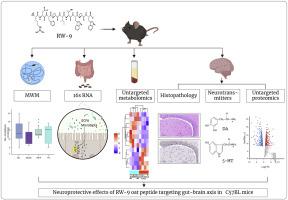Oat peptide ameliorates cognitive impairment via mediating gut-brain axis in mice: A multi-omics approach
IF 6.2
Q1 AGRICULTURE, MULTIDISCIPLINARY
引用次数: 0
Abstract
Oat protein-derived bioactive peptide (RW-9) has been reported to exert beneficial effects in memory deficits. However, the mechanisms underline the neuroprotective effects of RW-9 peptide against Alzheimer disease (AD) like symptoms remain unclear. In this study, we found that RW-9 intervention showed various improving effects in cognitive-behavioral tests and alleviated the oxidative stress and inflammation in scopolamine-induced mice model. The H&E staining results demonstrated the protective effects of RW-9 on hippocampal neurons. Proteomic analysis of hippocampus revealed the upregulation of memory related proteins, including Grin3a, Ppp2r1b, Stat6, Pik3cd, Slc5a7, Chrm2 mainly involved in cAMP signaling, PI3K-Akt signaling, and JAK-STAT signaling pathways. The administration of RW-9 significantly upregulated the neurotransmitters including Serotonin (5-HT), Dopamine (DA), and Arginine (Arg) in mice brain. In addition, it modulated the serum metabolic profile and increased the expression levels of ATP-binding cassette (ABC) transporters, biosynthesis of amino acids, and Amino acyl-tRNA biosynthesis among others. Furthermore, 16s-rRNA results illustrated that the RW-9 restored the abundance of Muribaculaceae, Lachnospiraceae, Lactobacillus, Clostridia and Bactericides. Consistently, RW-9 restored the levels of SCFAs. Taken together, our results suggest that the RW-9 may prevent the AD like symptoms via modulation of gut-serum-brain axis.

燕麦肽通过介导小鼠肠-脑轴改善认知障碍:一种多组学方法
燕麦蛋白衍生的生物活性肽(RW-9)已被报道对记忆缺陷发挥有益作用。然而,RW-9肽对阿尔茨海默病(AD)样症状的神经保护作用的机制尚不清楚。在本研究中,我们发现RW-9干预在东莨菪碱诱导小鼠模型的认知行为测试中表现出多种改善作用,并减轻氧化应激和炎症。H&;E染色结果显示RW-9对海马神经元的保护作用。海马蛋白组学分析显示,记忆相关蛋白上调,包括Grin3a、Ppp2r1b、Stat6、Pik3cd、Slc5a7、Chrm2,主要参与cAMP信号通路、PI3K-Akt信号通路和JAK-STAT信号通路。RW-9显著上调小鼠脑内5-羟色胺(5-HT)、多巴胺(DA)和精氨酸(Arg)等神经递质。此外,它还调节了血清代谢谱,增加了atp结合盒(ABC)转运体、氨基酸生物合成和氨基酰基trna生物合成等的表达水平。此外,16s-rRNA结果表明,RW-9恢复了Muribaculaceae、Lachnospiraceae、Lactobacillus、Clostridia和Bactericides的丰度。RW-9持续地恢复了scfa的水平。综上所述,我们的研究结果表明RW-9可能通过调节肠-血清-脑轴来预防AD样症状。
本文章由计算机程序翻译,如有差异,请以英文原文为准。
求助全文
约1分钟内获得全文
求助全文
来源期刊

Journal of Agriculture and Food Research
Multiple-
CiteScore
5.40
自引率
2.60%
发文量
193
审稿时长
69 days
 求助内容:
求助内容: 应助结果提醒方式:
应助结果提醒方式:


